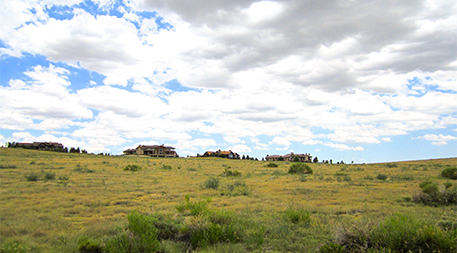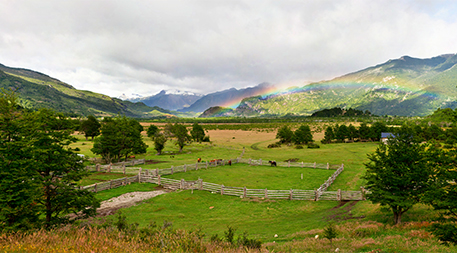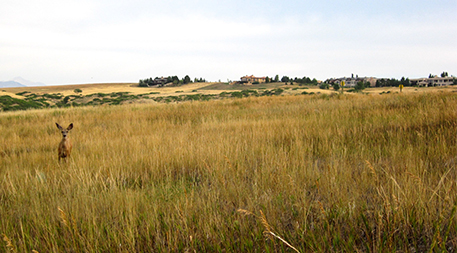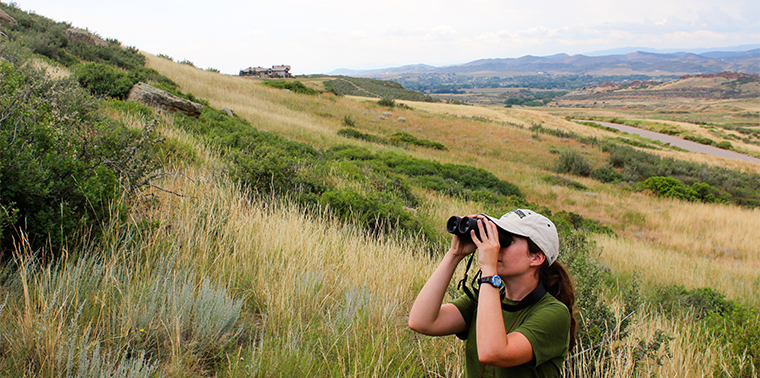January 5, 2015 — Fort Collins, Colo., is a growing, vibrant college town with a typical American problem: Beyond its idyllic historic city center, cookie-cutter subdivisions are eating away at farm fields, ranches and forests. According to the National Wildlife Federation, “the conversion of natural areas for homes, offices and shopping centers has become one of the most serious threats to America’s native plant and animal species.” It’s also a leading cause of biodiversity decline worldwide.
Yet one development, called the Hill at Cobb Lake, stands out from the turfgrass- and pavement-covered sprawl. Here, homes clustered along a single access road leave bird-filled meadows and ancient cottonwoods untouched.
The Hill is different because it was designed with the notion that rural and suburban housing don’t need to be a death sentence for biodiversity. Homes here are strategically clustered to preserve the most ecologically valuable parts of the land.

At the Hill at Cobb Lake, clustered homes leave wildlife-friendly open spaces intact rather than chunking them up into individual lots. Photo by Cooper Farr.
As population booms gobble up wild lands, communities and conservationists worried about the loss of open space are increasingly turning to conservation developments like the Hill to help preserve ecosystems and rural landscapes at scales that wouldn’t be possible with public funding alone. Such developments are designed, built and managed to prioritize natural resources alongside housing. They work to stave off habitat loss by keeping the most important parcels for wildlife intact, often putting them into conservation easements, rather than turning them into roads or lawns. In the best cases they maintain ecosystem functions such as improving water “It’s a way to achieve conservation in the context of development that is going to happen anyway.” — Sarah Reedquality and carbon uptake and help preserve animal movement corridors by strategically linking to other protected areas. In addition to setting aside land, they employ an array of conservation techniques, from using constructed wetlands to treat wastewater to defending against invasive species takeovers and restoring habitat such as native grasslands and trout streams.
“It’s a way to achieve conservation in the context of development that is going to happen anyway,” says Sarah Reed, a conservation biologist for the Wildlife Conservation Society and affiliate faculty member at Colorado State University studying conservation developments.
Conservation developments already account for a quarter of the private land set aside in the U.S. As their popularity grows, ecologists and conservation biologists like Reed are working to identify how to design, regulate and manage them to make them most helpful for biodiversity.
Zone Defense
Traditional zoning can be a major enemy of preserving habitat and movement corridors, both important requirements for wildlife, says Randall Arendt, a Rhode Island–based pioneer of U.S. conservation planning.
For example, local governments often try to limit the density of rural growth by setting lower limits on lot sizes. The outcome can be seen in suburbs all over the U.S. as developments divide open spaces into human-dominated checkerboards, leaving little interconnected land for wildlife or common recreational space for residents.
In 1997, nearly 25 percent of non-governmental conservation efforts in Chile came in the form of “conservation communities.”Some local governments try to remedy that zoning problem by writing rules that allow higher density housing and sometimes reduce application fees or fast-track applications if developers set aside a fraction of their subdivisions for conservation. A study Reed published in 2014 found that nearly one-third of counties in the western U.S. had such rules, with most adopted in the past decade.
“There’s clearly a growing interest in the tool,” says Reed.

The for-profit conservation business Patagonia Sur aims to protect vast stretches of land in Chile by pairing development with land set-asides. Photo courtesy of Patagonia Sur.
That’s true not only in the U.S., but internationally as well. In 1997, nearly 25 percent of non-governmental conservation efforts in Chile came in the form of “conservation communities” where individuals buy shares in developments that allow them to build a home on a parcel while preserving the rest as a communal park. Patagonia Sur, a for-profit conservation group with headquarters in Santiago and Massachusetts, has purchased more than 60,000 acres since 2007. It plans to sell that land to buyers who agree to develop less than 15 percent for real estate or ecotourism, setting aside the rest to be held by one of Chile’s first land trusts. Chile’s congress is making progress toward encouraging conservation of public land by considering a law that will allow for conservation easements similar to those in the U.S. And in South Africa, one of the world’s most biodiverse countries, grassroots conservancies are forming to protect ecosystems while still allowing development and agriculture.
Willingness to Innovate
Even with the best policies promoting conservation development, “maverick developers” willing to try innovative designs are still key for getting more sustainable subdivisions on the ground, says Mark Hostetler, an urban ecologist and professor at the University of Florida.
One development Hostetler worked on in Gainesville, called Madera, has landscaping that helps runoff naturally infiltrate the soil rather than flushing polluted stormwater into lakes and ponds. Instead of turfgrass, its lawns are covered in native plants. The streets are narrow, curbless and gutterless, all designed to minimize pavement. Initially, it was difficult to get the county’s approval for such features, but Madera planted the seed for new regulations that now make it easier for others.
In a 2013 study Reed and her colleagues found that properties in conservation developments command prices 25 to 29 percent higher than similar homes in traditional Colorado subdivisions.
Still, “there’s no one single way to do conservation development,” says Hostetler. “It’s all site dependent.” Conservation developers need to take extra care to preserve an area’s unique features by, for example, avoiding bulldozer damage to big, old tree roots, maintaining wetlands that will entice sandhill cranes and other wildlife, or leaving dead tree trunks in place for woodpeckers and owls.
Conservation development may seem at odds with a developer’s interests, when on the surface the job is to make the most money from a given tract of land. While some developers do it for altruistic reasons, there is evidence that valuing nature can lead to higher-dollar homes. In a 2013 study Reed and her colleagues found that properties in conservation developments command prices 25 to 29 percent higher than similar homes in traditional Colorado subdivisions.
“We know from our economics study that developers and homeowners are benefiting from the fact that these developments are marketed as conservation developments,” says Reed.
What About Biodiversity?
As conservation developments grow in popularity, Reed has one big — and very important — question: “Are they actually achieving meaningful conservation of native plant and animal species in these developments?”
When she and her colleagues analyzed ordinances and regulations governing conservation developments in the Western U.S., they found them often to be weak and not backed up with science. Only 13 percent required consultation with an ecologist. And few included long-term management plans or homeowner education on topics such as coexisting with wildlife.
“I don’t think that the guidelines were lacking for lack of good intentions,” says Reed. “I think they were lacking because conservation biologists hadn’t taken it upon themselves to help.”

Colorado State University ecology graduate student Cooper Farr has found that native vegetation, open space and home densities are key to keeping developments wildlife friendly. Photo by Cooper Farr.
That’s why one of Reed’s graduate students, Cooper Farr, is studying which aspects of conservation developments are most important for biodiversity. She’s observing birds, mammals, plants, even people and their pets, to learn how design features and management issues, such as the presence of domestic animals, mowing or vegetation type, affects native species.
Farr’s analysis of 14 Colorado subdivisions, from the mountain foothills to the valley floor is ongoing, but early results reveal that native vegetation, continuous open space and surrounding home densities are the most important factors determining if subdivisions support songbirds usually displaced by development. She’s seeing similar patterns for mammals such as elk, mule deer, coyotes and black bears.
Imperfect but Good
Even with the best data, conservation development is an imperfect solution compared to land use planning that concentrates development in cities and leaves open space relatively untouched, says Rainforest Alliance lead scientist Jeffrey Milder, who has studied sustainable residential development. But, he adds, it is still important for carving out habitat that would have been lost otherwise — in other words, not letting the perfect be the enemy of the good.
“A lot of people focused on smart growth are focused on trying to make cities better and more livable,” he says. “I think those people ought to be embracing tools like conservation development to deal with what happens in the rural areas and the exurbs. We need a different set of tools for those areas, and those tools can’t be ‘no one can do anything there, ever.’” ![]()
Ensia shares solutions-focused stories free of charge through our online magazine and partner media. That means audiences around the world have ready access to stories that can — and do — help them shape a better future. If you value our work, please show your support today.
Yes, I'll support Ensia!

If one starts out with density requirements that take into account a concept of "carrying capacity - and then clusters the houses on a small piece of the land, leaving the rest open, one has a better chance of minimizing impact ....
I agree, the best development is no development but the problem is, when one attempts to zone for no development, the sticky wicket of "taking" crops up - almost invariably requiring some sort of compensation to property owners "denied the use of their land" ....
I was involved for about 10 years, some time ago, in issues around this - one can't avoid the politics of the situation - one has to become immersed in them and once one gets the "lay of the land", so to speak, one realizes how one must deal with them ....
However, it is true that planning reasons and technical criteria are more often than not disregarded when the wild card of politics is at play.
Because of the prospects for big profits involved with developing low-price agricultural land, developers are always ahead of the public, way before their projects become known.
Developers often begin working even before the municipal election to secure enough of their candidates get into council.
If a majority of pro-development councillors get elected--and most of the time they'll do--then the process is flawed from then on, and development proposals, bad or mediocre, will be approved no matter what.
Agree - the process is a persistent one - landowners know where the power of zoning lies and do the most they can to be in control of the process - getting appointed to Planning Boards, etc. and running for Town Board. Most folks don't get pay much attention until they notice that something they don't like shows up in their neighborhood and by then it is often too late ....
My experience impressed on me the importance of politics - of the necessity of paying attention, becoming involved and putting decent folk in office - one can be a committed activist but it can all be undone at the next election .....
In any event, the dream of "getting away from it all" has begun to fade as people realize the impact of long commutes to work, the inconvenience of living away from urban services such as fire or ambulance, and the permanent need to drive the kids if they're going to get some social life.
Urban spaces too are now looking at reducing outward expansion by creating more dense and less car-dependent neighbourhoods.
Europe has long understood the need to draw lines and protect their non-urban landscapes.
Let's put the ecological value of the land upfront instead of considering it a commodity.